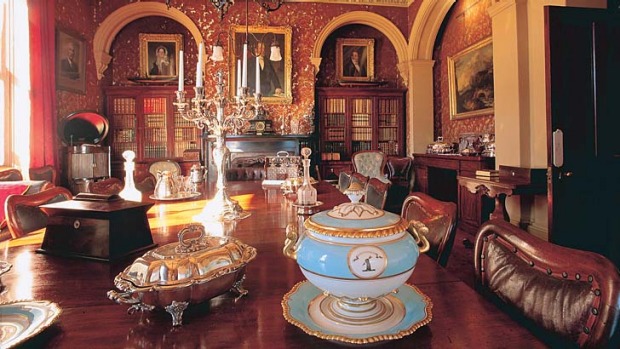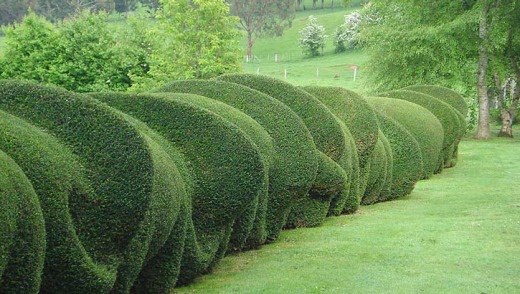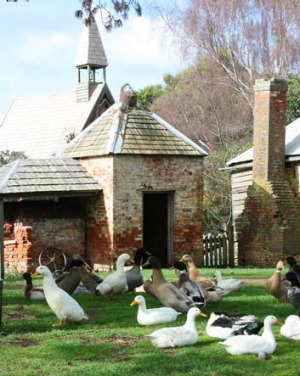
Sam Vincent tours key estates where guests stay in heritage surrounds that date to the early days of settlement.
Tasmania has Australia's finest collection of Georgian and early Victorian manors, many still occupied by the descendants of the wool, shipping and whaling magnates who built them. Some are working properties, others are now B&Bs. All have extensive grounds and many are open to day visitors. Book a stay and you'll have some of the nation's finest heritage to yourself. Here are five key estates to explore.
Richard and Louise Archer are the sixth generation of Archers to farm Brickendon, a 450-hectare swath of grassland near Longford irrigated by the meandering Macquarie River and backed by the imperious Great Western Tiers.

Settled by William Archer in 1824, the property's 22 heritage-listed buildings were built by 1200 convicts, and include a Dutch barn, cute chapel and the whitewashed Georgian manor where the Archers live. Though the house itself isn't open to the public ("We're pretty messy," Louise says), the grounds are. Considered by some to be Tasmania's best garden (apart from Hobart's Royal Botanical Gardens), the highlight is an unusual collection of trees including a 180-year-old bunya so big its lower branches are supported by stakes.
Brickendon, along with the nearby Woolmers Estate, is a World Heritage-listed property. Accommodation is in convict-built and beautifully restored cottages on Brickendon's vast estate.
Brickendon, 236 Wellington Street, Longford. Gardener's Cottage costs $190 a night for two, including breakfast provisions. Colonial village and garden open to the public Tues-Sun, 9.30am-4pm. Phone (03) 6391 1383; see brickendon.com.au.

It's a 40-minute walk from Brickendon along a paddock path to neighbouring Woolmers, settled by William Archer's brother, Thomas, in 1817. But though the Archers of Brickendon have become a Tasmanian dynasty, Thomas Archer VI (1917-94) never produced an heir. Tant mieux - Woolmers is now run by a public trust and is entirely open to the public.
The mansion affords sweeping views of the Norfolk Plains and its architecture offers a succinct history of the property. What was once the front of the main house is now the back, a low-roofed, no-nonsense facade that hints at its original function: shelter from bushrangers and the elements.
Then in the 1840s, with Thomas growing rich from wool, he splurged and commissioned a lavish Italianate extension popular at the time among the colony's nouveau riche - a kind of Van Diemonian McMansion.
Inside, the interiors have changed little in 170 years. But it is outside I most enjoy. The wooden woolshed, which looks like a manor itself, is Australia's oldest, and the homestead's walled garden, initially designed to separate the Archers from the convicts, is an oasis of winding paths, fountains and flower beds. There's even a "smoking room", complete with pole so gentlemen could run up a flag when they were out of tobacco. Now that's service.
Woolmers Estate, 658 Woolmers Lane, Longford. Seven fully restored, self-contained cottages are available, from $145 a night for two. The 1840s Tally-Ho (Coachman's Cottage) sleeps six. The estate is open for day tours Monday-Friday, 10am-4pm. Phone (03) 6391 2230; see woolmers.com.au.
When Francis Tabart settled the Eastern Marshes near Oatlands in 1830, he wanted to make a statement. It took 10 years for his convict labour force to complete it, but in Fonthill, an austere, sandstone folly, he succeeded.
"It looks scary, but it's not," Susie Harvey says of the Gothic manor she grew up in. Harvey is an enthusiastic guide, flitting about like a swallow as she shows me its unique features (the maids' quarters were conveniently located beside Tabart's bedroom to aid his notorious philandering; the room in which his wife died has been furnished the way it would have looked during her lifetime).
Outside, there's a wood-fired oven that can cook 32 loaves of bread, plus a ghoulish collection of metal traps for catching escaped convicts.
Fonthill, 1025 Lemont Road, Lemont. The Shearer's Quarters can accommodate large groups; the Settler's Cottage can sleep eight. From $120 a night for two. Day visitors also welcome. Phone (03) 6255 5101, see fonthill.net.au.
Redlands opens to the public in November. A magnificent estate evolving from a land grant made in 1819 to George Frederick Read, a son of King George IV, Redlands occupies fertile Derwent Valley grounds on the River Plenty. A major hops plantation, it employed more than 200 people at its peak.
The remains of what was once a seasonal village - including a butchery, bakehouse and hops-drying barn built from 90,000 convict-made bricks - still stand among gnarled poplars and copper beeches that are thought to be among Australia's oldest. Above the estate's ivy-clad 1822-built Georgian manor, bells in the belfry once tolled the start and end of the working day.
Redlands was recently bought by Sydney couple Peter and Elizabeth Hope, who plan to revive it via whisky rather than beer; local distiller Bill Lark will use barley grown on the property and guests who stay on site can be involved in mashing and brewing processes.
"There's a nice symmetry here," Peter says. "Not only will barley from the property be distilled into whisky here, but wheat grown at Redlands will be milled at the southern hemisphere's oldest mill [in Oatlands] before being brought back here to be made into bread in Tasmania's oldest bread oven."
Redlands, 759 Glenora Road, Plenty. Self-contained accommodation in an annexe off the main homestead is planned (rates to be decided). A visitor centre and cellar door sales are also planned. Phone (03) 6261 1122.
A pale Georgian manor in the Meander Valley, Old Wesleydale has a black history. In 1829, the Van Diemen's Land frontier wars were at their height, and the manor, a day's coach ride from Launceston, was on the front line.
"They were waiting for the Aborigines to attack," says the property's proprietor, Deb Wilson, as we admire Old Wesleydale's fortified stone compound.
The mist-licked hills behind us once housed an ochre quarry attracting indigenous Tasmanians from as far afield as present-day Devonport, and for Henry Reed, the shipping and whaling magnate who lived here, their presence was threatening.
The Aborigines never attacked, and Reed's defences survived. Old Wesleydale's courtyard is surrounded by three-metre fortifications while the adjoining barn is equipped with gun slits.
The manor itself - which Deb says I should call a cottage because it "only" has 11 rooms - is a fine example of Georgian architecture, all handsome square dimensions and symmetrical chimneys.
The buttery at Old Wesleydale houses self-contained B&B accommodation.
Old Wesleydale, 1970 Mole Creek Road, Mole Creek. The restored old buttery has self-contained accommodation from $130 a night for two. Includes breakfast provisions. Phone (03) 6363 1212; see oldwesleydaleheritage.com.
Sam Vincent travelled courtesy of Tourism Tasmania.